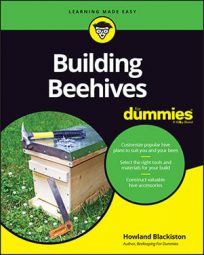The hive-top feeder is just one of several feeder designs you can use to offer sugar syrup to your bees when the nectar flow is minimal or nonexistent. Feeders also provide a convenient way to medicate your bees if you decide to do so (many medications can be dissolved in sugar syrup and fed to your bees).
![[Credit: Illustration by Felix Freudzon, Freudzon Design]](https://www.dummies.com/wp-content/uploads/357112.image0.jpg)
Vital stats for the hive-top feeder
Size: 19-7/8 inches x 16-1/4 inches x 3-1/2 inches (for a feeder to fit a ten-frame Langstroth-style hive).
Capacity: The hive-top feeder holds approximately 2 gallons of sugar syrup (this capacity is for the feeder that fits on a ten-frame Langstroth- style hive; the amount is slightly less if you're building a feeder for an eight-frame hive). You need to build one hive-top feeder for each hive in your apiary.
Universality: This particular design fits the ten-frame Langstroth hive. But if you modify your measurements a little, a version of this feeder fits nicely on top of an eight-frame Langstroth. By making other adjustments to the measurements, you can tweak the feeder to fit on a Warré hive or a British National hive.
Degree of difficulty: This feeder is a little tricky to build because of the screening material and the construction detail within the feeding area. Ensuring that the feeder is watertight and doesn't leak can also be tricky. Other than that, not much more is involved than building a simple wooden box.
Cost: Using scrap wood (if you can find some) would keep material costs of this design very minimal, but even if you purchase the recommended lumber, hardware, and fasteners, you can likely build this hive-top feeder for less than $50 (a little less if you use knotty pine lumber).
Material list for the hive-top feeder
The following table lists what you'll use to build your hive-top feeder. In most cases, you can make substitutions as needed or desired.
| Lumber | Hardware | Fasteners |
|---|---|---|
| 1, 12' length of 1" x 4" clear pine lumber | Optional: weatherproof wood glue | 28, 6 x 1-3/8" deck screws, galvanized, #2 Phillips drive, flat-head with coarse thread and sharp point |
| 1, 2' x 4' sheet of ¼" lauan plywood | A pint of exterior polyurethane or marine varnish | 12, 5/32" x 1-1/8" flat-head, diamond-point wire nails |
| A tube of silicone caulking (as used for fish aquariums) or melted beeswax | 3/8" staples for use in a heavy-duty staple gun | |
| 1/8" hardware cloth (typically comes in 3' x 10' rolls, but some beekeeping supply vendors sell #8 hardware cloth by the foot; you only need a couple of feet for this project) |
Here are a few tips for purchasing materials for your hive-top feeder:
Clear pine is not too expensive as board lumber goes. Knotty pine is even less expensive.
There are a few more fasteners than you'll need just in case you lose or bend a few along the way. It's better to have a few extras on hand.
One hive uses one feeder, so if you plan on having a couple of hives, you need to double all the materials in the preceding table to build a couple of hive-top feeders.

